#Pantanal Wildlife Center
Text
As planet heats, Brazil's anteaters face rising extinction risk
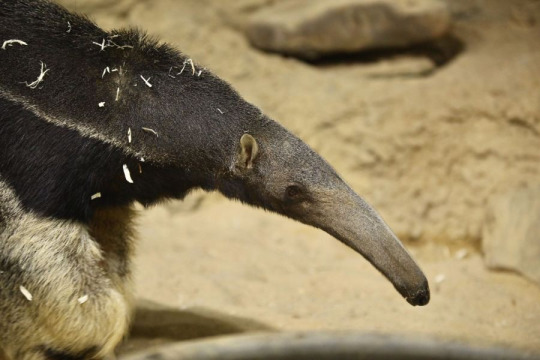
As their geolocator device beeps, the team of wildlife rehab experts approach a cluster of trees and spot their quarry: A young giant anteater, sleeping on a hot morning with her luxuriant tail shading her head.
She is a survivor of a fire holocaust that swept through Brazil's vast southern Pantanal in 2020, killing an estimated 17 million animals and burning nearly a quarter of the drought-parched wetlands and grasslands region, which is about the size of New York state.
Rescued alone on the side of a highway, at an age when she should have been still clinging to her mother's back, the young anteater has since been cared for by Orphans of Fires, a project in Mato Grosso do Sul state that hopes to help her return permanently to the wild.
Started in Aquidauana by conservationists in the wake of the fires, it now cares for 15 rescued giant anteaters.
"There are termite mounds all around", notes veterinarian Maria Helena Mazzoni Baldini approvingly - a sign the sleeping young orphan is fending for herself, though she was too young to learn foraging skills from her mother.
In 2020, more than 50 giant anteaters injured or displaced by the Pantanal fires were taken in by state rescue projects - a leap from 13 the previous year, according to Mato Grosso do Sul's Wild Animals Rehabilitation Center (CRAS).
As fires grow larger and more frequent and as global warming brings hotter and drier conditions, the already endangered anteaters - which also live in the Amazon rainforest - are coming under growing pressure.
Continue reading.
#brazil#politics#brazilian politics#environmentalism#climate change#animal rights#mod nise da silveira#image description in alt
2 notes
·
View notes
Text
BRAZIL–“Symphony of Survival” tells the heartbreaking story of people saving animals amidst some of the most tragic wildfires in Brazil’s history. Check out the trailer below!!
Directed by Michel Coeli, the film centers on the 2020 Pantanal wetland fires in the Amazon. The Pantanal is home to vast wetlands larger than Greece and stretches over parts of Brazil, Bolivia, and Paraguay. The region boasts some of the highest concentrations of wildlife on the planet, including jaguars, tapirs, hyacinth macaws, and endangered giant otters. The wetlands play a crucial role in regulating South America’s water cycle, preventing floods and droughts, and storing significant amounts of carbon. Like a tub, the wetland swells with water during the rainy season and empties out during the dry months. In 2020, drought conditions spurred on by climate change turned the Pantanal into a tinder box and then an inferno.
"Symphony of Survival" not only documents this tragic environmental crisis but also highlights the Pantanal's irreplaceable diversity and the urgent need for environmental preservation.
We are proud to announce that director Michel Coeli is the latest recipient of our Cultures of Resistance Awards!
Follow Michel Coeli here:
Read more about our award here:
https://culturesofresistancefilms.com/michel-coeli/
1 note
·
View note
Text
youtube
Certainly! Brazil is a vast and diverse country known for its stunning landscapes, vibrant culture, and friendly people. Here's a travel guide to help you explore some of the highlights:
1. Rio de Janeiro:
Christ the Redeemer: Visit the iconic statue atop Corcovado Mountain for breathtaking views of the city.
Sugarloaf Mountain (Pão de Açúcar): Take a cable car ride to the summit for panoramic views of Rio and its coastline.
Copacabana and Ipanema Beaches: Enjoy the sun, sand, and vibrant beach culture.
Tijuca National Park: Explore the lush rainforest within the city limits.
2. São Paulo:
Paulista Avenue: The heart of São Paulo, lined with museums, shopping centers, and cultural institutions.
Ibirapuera Park: A large green space with museums, walking trails, and a lake.
Vila Madalena: A bohemian neighborhood known for its street art, bars, and nightlife.
3. Amazon Rainforest:
Manaus: Gateway to the Amazon, explore the meeting of the waters, and visit the Teatro Amazonas.
Amazon River Tours: Take a boat trip to experience the incredible biodiversity of the rainforest.
4. Salvador:
Pelourinho: The historic district with colorful colonial architecture, music, and lively markets.
Capoeira Shows: Experience the traditional Brazilian martial art and dance form.
5. Iguazu Falls:
Marvel at the spectacular Iguazu Falls, a UNESCO World Heritage site, located on the border with Argentina.
6. Pantanal:
Explore the world's largest tropical wetland area, known for its diverse wildlife, including jaguars and exotic birds.
7. Florianopolis:
Enjoy beautiful beaches, sand dunes, and hiking trails on this island known for its natural beauty.
8. Brasília:
Visit the capital city, known for its modernist architecture and unique urban planning.
9. Bahia:
Explore the Afro-Brazilian culture, enjoy local cuisine, and relax on the beaches of Bahia.
10. Beaches in the Northeast:
Visit stunning beaches like Porto de Galinhas, Jericoacoara, and Praia do Forte for sun, sand, and water activities.
11. Carnival:
If possible, experience the world-famous Rio Carnival, a vibrant celebration of music, dance, and culture.
12. Local Cuisine:
Try Brazilian dishes like feijoada, açaí bowls, coxinha, and various regional specialties.
13. Safety Tips:
Be cautious in large cities and tourist areas regarding personal belongings.
Stay informed about local safety conditions and follow local advice.
14. Language:
Portuguese is the official language, so it's helpful to know a few basic phrases.
15. Local Culture:
Brazilians are known for their warm hospitality, so embrace the local culture and enjoy the diverse music and dance scenes.
Remember to check travel advisories and health guidelines before planning your trip. Brazil offers a rich tapestry of experiences, from the bustling cities to the pristine natural wonders. Enjoy your travels!
#Brazil#Brasil#VisitBrazil#BrazilianBeauty#BrazilianVibes#ExploreBrazil#BrazilianCulture#BrazilianAdventure#BrazilianParadise#BrazilianLifestyle#BeautifulBrazil#LoveBrazil#BrazilianBeaches#BrazilianJungle#BrazilianSunset#CarnivalinBrazil#RioDeJaneiro#SaoPaulo#IguazuFalls#AmazonRainforest#brazilcountry#braziltravel#Youtube
0 notes
Video
Capybara-Brazil2010f-2606.jpg by Dagget2
4 notes
·
View notes
Photo



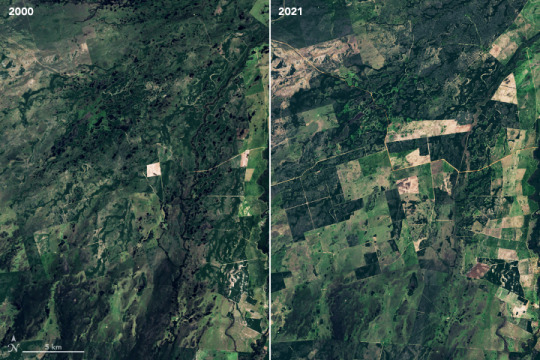
A Human Fingerprint on the Pantanal Inferno One of the world’s largest freshwater wetlands—the Pantanal—spreads across a bowl-shaped plain where Bolivia, Brazil, and Paraguay meet. During the rainy season in most years, floodwater drains from several swollen South American rivers into this vast inland delta, replenishing swamps and marshes. The region is home to thousands of plant and animal species, including rare and endangered jaguars, hyacinth macaws, and giant river otters. But in both 2019 and 2020, with the region gripped by severe drought, those refreshing floodwaters never came. Come June and July, fires did instead. They burned sporadically at first, but by August and September, they raged with such ferocity that they left vast swaths of the Pantanal blackened. The fires blanketed cities near and far with a pall of smoke. The burning was severe in 2019, charring roughly 16,000 square kilometers (6,200 square miles). But in 2020, the scale was catastrophic, burning one-third of the whole biome. A remarkable 39,000 square kilometers (15,000 square miles) burned in 2020, an area about the size of Switzerland. In the immediate aftermath of the 2020 fires, the simple explanation for the extensive fires was that unusually dry, hot weather had fueled them. But a new study led by NASA scientists suggests that human activity played a critical role in exacerbating them. The study was published in Scientific Reports in January 2022. “It is certainly true that extreme heat and drought in 2020 worsened the fires, but that’s not the whole story,” said Sujay Kumar, a hydrologist at NASA’s Goddard Space Flight Center. “It is also clear, based on a range of data, that these fires would not have happened in the absence of human activity. We even saw a very specific pattern of fire activity that suggests people allowed or even encouraged fires to burn in forested areas.” Together with colleagues from the Federal University of Rio de Janeiro, Cardiff University, and NASA’s Marshall Space Flight Center, Kumar analyzed land cover and burned area data from NASA’s Moderate Resolution Imaging Spectroradiometer (MODIS), precipitation data from the Global Precipitation Measurement (GPM) mission, and soil moisture data from the Soil Moisture Active Passive (SMAP) satellite. The team also considered the density of cattle operations. “With over 52 percent of natural areas burned compared to only 6 percent of regions with high-cattle density, it is clear that natural, not human-dominated landscapes were most affected by the 2020 fires,” said study co-author Niels Andela, a remote sensing scientist at Cardiff University. “The sensitivity of natural landscapes to fire-driven degradation has been a concern across the southern Amazon for years. With this research, we provide the first large-scale evidence that the same mechanisms may be applicable across the tropics, including in the Pantanal.” The researchers also looked for signs that the fires may have changed the ecosystem in lasting ways. They examined the region's hydrology—how water flows across the landscape—using a data assimilation model called the Land Information System. The LIS combines satellite- and ground-based observations with modeling techniques that characterize land surface conditions. “Several months after the fire, we saw clear evidence of decreased evapotranspiration and more surface runoff, trends that can trigger or accelerate desertification,” said NASA hydrologist Augusto Getirana, one of the study’s co-authors. Scorched soils with less vegetation can mean less rainfall being soaked up by plants, more water and sediment running off the land into streams, and less moisture exchange with the air above. “All of this adds up to increased land degradation.” Changes like these could cause new challenges for the region’s wildlife, which have already been hit hard by the burning and may struggle under new environmental conditions. One group of biologists that surveyed the Pantanal soon after the fires estimated that at least 17 million vertebrates were likely killed, including millions of snakes, rodents, and birds. While conservation areas and indigenous territories have been set up to limit development in parts of the Pantanal, the human fingerprint on the landscape is sizable and growing. Another recent study estimated that the amount of the Pantanal devoted to agriculture—typically cattle pasture—has increased by 3.5 percent per year since the mid-1980s. Some 3.8 million cattle are now spread among 3,000 farms, according to one estimate. Ranchers in the Pantanal regularly use fire to maintain pastures and sometimes to clear areas to establish new pastures. The expansion of pasture is evident in the pair of natural-color Landsat images above, which show part of Mato Grosso do Sul near Morrinho. While the area had minimal development and was mostly natural in 2000 (left image), much of it had been converted into pasture by 2021 (right image). Clearings for pastures appear as light green and brown rectangles. Surface water is dark blue. “As in other parts of the Amazon Basin, we are essentially seeing an arc of deforestation and land cover change spread along the Upper Paraguay River,” said Renata Libonati of Federal University of Rio de Janeiro. “There is little that is natural about these fires. Some were probably lit intentionally to maintain pastures on or near ranches. Others were accidental but associated with human activities—things like campfires, burning trash, electrical wires, motor vehicles, hunting, and beekeeping.” Lightning sometimes ignites fires in the Pantanal, but these fires tend to be small, causing just 5 percent of the total burned area on average. Also, lightning-triggered fires generally burn in the austral summer (December-February) not the winter (June-August). Further encroachment, combined with climate change and fires, is worrisome to Libonati. "We know that compound drought-heatwaves like we saw in 2020 are likely to become more common in the future due to climate change," said Libonati. “It’s become obvious that we’re going to need long-term management strategies to protect the Pantanal from future fire outbreaks like this.” NASA Earth Observatory images by Lauren Dauphin, using data from Kumar, Sujay, et al. (2022) and Landsat data from the U.S. Geological Survey. Story by Adam Voiland.
5 notes
·
View notes
Photo
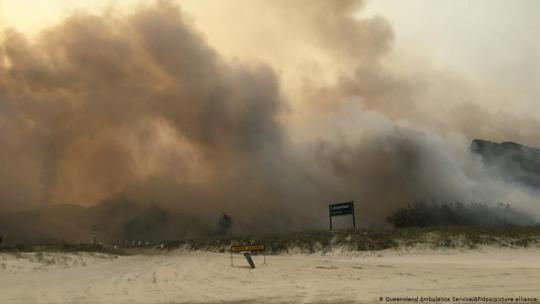
New Post has been published on https://freenews.today/2020/12/08/wildfires-fraser-island-is-just-one-unesco-heritage-site-threatened-by-climate-change-dw-08-12-2020/
Wildfires: Fraser Island is just one UNESCO heritage site threatened by climate change | DW | 08.12.2020

On the small sandy paradise of Fraser Island, or K’gari, off the east coast of Australia, the indigenous Butchulla people have maintained the delicate ecosystem of the rainforest on the sand dunes with controlled fires — known as “cool burns” — for generations.
But there was nothing controlled about the enormous bushfire that began spreading across the island more than seven weeks ago. Believed to have been started by a tourist campfire in October, the blaze reached its peak this weekend when it tore through the island’s rainforest and forced many residents to evacuate their homes.
So far, the houses of the island’s 200 residents have been spared the flames — but the same cannot be said of the natural landscape on the World Heritage-listed island. Over half the rainforest — 8,500 square kilometers (3,282 square miles) according to dpa news agency — has been destroyed by the fires.
The devastation comes at the beginning of Australia’s wildfire period. Last year, in what became known as “Black Summer,” some of the most deadly and widespread fires the country has ever witnessed killed 1.25 billion animals according to conservation organization, World Wildlife Fund (WWF), burned houses to the ground and destroyed hundreds of thousands of square kilometers of bush.

On Fraser Island, the rainforest grows on sand dunes
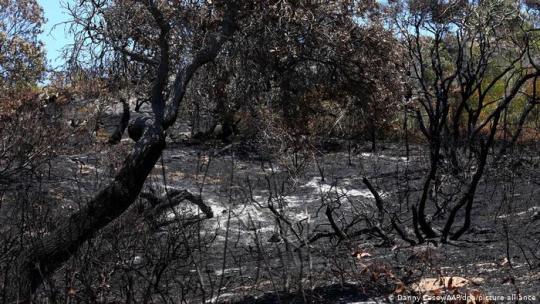
The fire has left much of the rainforest destroyed
“Fire seasons are lengthening worldwide, and we know that in Australia our fire seasons are starting earlier and finishing later, with more dangerous fire days occurring earlier in the season than they have previously,” Richard Thornton, CEO of the Melboure-based non-profit Bushfire and Natural Hazards Cooperative Research Center, told DW by email.
“Climate change plays a role in this — Australia is now one degree Celsius warmer compared to the long-term average, which means that the variability of ‘normal’ events sits on top of that,” he added.
UN report blames climate change
The destruction of the island’s natural heritage comes as a new UN-backed report names climate change as the top threat to natural World Heritage sites. Researchers found one third of sites on the UNESCO list are now threatened by global heating.
The report — the World Heritage Outlook 3 — was authored by the International Union for the Conservation of Nature (IUCN), a government and civil society group that advises UNESCO, the UN’s culture agency.
“Natural World Heritage sites are among the world’s most precious places, and we owe it to future generations to protect them,” Bruno Oberle, IUCN director general said in a statement.
“As the international community defines new objectives to conserve biodiversity, this report signals the urgency within which we must tackle environmental challenges together at a planetary scale.”
Among the threats to 83 of the 252 World Heritage Sites are shrinking glaciers, an increase in the incidence and ferocity of fires, floods and droughts and coral reef bleaching — an impact of ocean acidification, which is caused by high levels of CO2 emissions.
The Great Barrier Reef, which is situated near Fraser Island, was singled out as one of the sites most at risk. The world’s largest tropical wetland, the Pantanal Conservation Area in Brazil, was badly damaged by extensive fires in 2019 and 2020, while the melting of the Kaskawulsh Glacier caused by rising temperatures in Canada’s territory of Yukon has depleted fish populations in Kluane Lake. A lack of of glacial run-off means large swathes of the lake are drying up.
“The findings of the report point to a dire need for adequate resources to manage our irreplaceable natural areas,” said Peter Shadie, Director of IUCN’s World Heritage Program in a statement.
According to the study, which is the third following previous assessments in 2014 and 2017, 16 of the nature sites have deteriorated in the last three years. Only eight have improved. Over a third of sites were also assessed as being at risk: 30% were of “significant concern” and 7% are “critical.” These include the Great Barrier Reef, the Tropical Rainforest Heritage of Sumatra in Indonesia and the Lake Turkana National Park in Kenya.

Fires devastated parts of Brazil’s Pantanal wetlands earlier this year
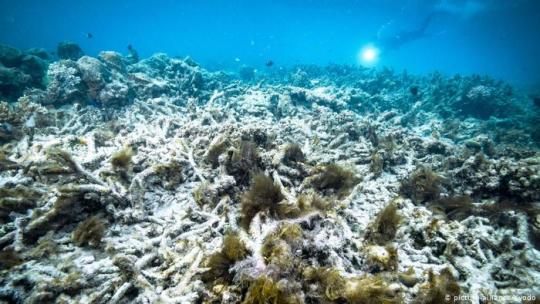
The Great Barrier Reef has lost around half its corals since the 1990s
‘Our extremes are more extreme’
Among those sites with a more positive outlook are the Comoe National Park in Ivory Coast which Shadie identifies as an “inspiring example.” After concentrated conservation efforts to counter the effects of climate change in the park, populations of chimpanzees, elephants and buffaloes are stable and rare bird populations are on the rise.
For Fraser Island, the opposite may be true. Though the report was published before the current fire started burning, the authors noted that an increase in fires posed the greatest threat to the sandy island.
“Changes in the plant communities (on Fraser Island) may be driven by future climate change and accelerated by the increase in fires,” the IUCN report says. “It is felt that modern regimes driven by climate change will result in a decrease in native biodiversity with a possible increase in pyrogenic invasive plant species.”
“Our extremes are more extreme — hotter and windier, and when it does rain, it rains more intensely,” Australia bushfires expert Richard Thornton explained.
“It is extremely difficult to attribute any one bushfire, flood or cyclone to climate change,” he added. “But climate change is changing our underlying weather conditions, and causing more severe weather,” he added.
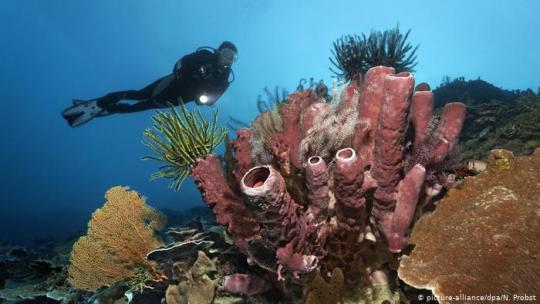
Doomsday tourism and climate change: Visiting natural wonders before they disappear
Transient treasure
Of the 2 million-odd people who visit the Great Barrier Reef annually, a 2016 survey found that 69 percent were coming to see the UNESCO World Heritage site “before it’s too late.” And no wonder. The IPCC says that even if we manage to limit global warming to 2 degrees Celsius, 99 percent of the world’s coral will be wiped out. Tourists can hasten their demise by touching or polluting reefs.
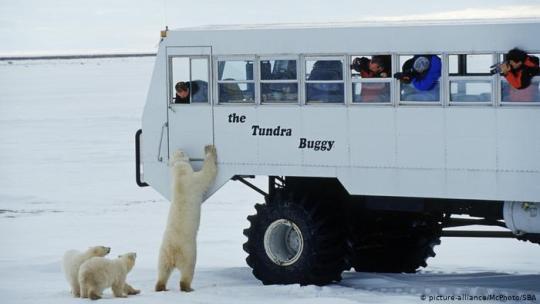
Doomsday tourism and climate change: Visiting natural wonders before they disappear
Bearly there
And what’s the carbon cost of flying to remote natural wonders under threat? A 2010 study found that the business of polar-bear safaris in Churchill, Canada, had an annual CO2 footprint of 20 megatons. Most visitors arrived by plane, and while 88 percent of them said humans were responsible for climate change, only 69 percent agreed that air travel was a contributing cause.

Doomsday tourism and climate change: Visiting natural wonders before they disappear
Art of the apocalypse
Along with the polar bear, one of the most iconic images of climate change must be the dramatic curves of an iceberg sculpted by the warming atmosphere. Gliding between the melting giants on a cruise ship is a haunting experience that tourists will pay huge sums for. In the early 1990s just 5,000 people visited Antarctica each year, compared to over 46,000 in 2018.
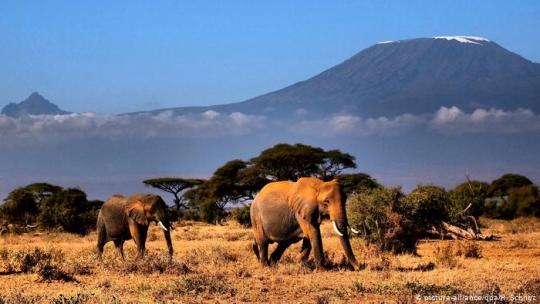
Doomsday tourism and climate change: Visiting natural wonders before they disappear
Peak season
You don’t have to go to the poles to see vanishing ice. Kilimanjaro’s snowy peaks are a striking sight above the equatorial savannah of the national park, which generates €44 million ($50 million) from tourism annually. Many visitors climb to the Furtwängler Glacier — where 85 percent of the ice has vanished over the last century. The rest is unlikely to survive much beyond mid-century.
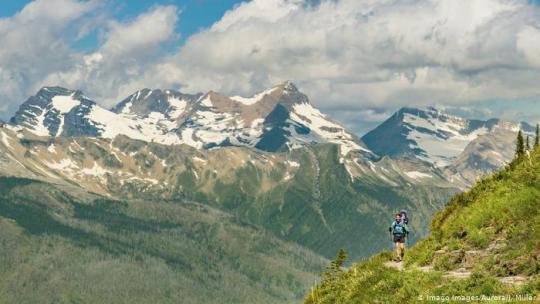
Doomsday tourism and climate change: Visiting natural wonders before they disappear
King without a crown
When Montana’s Glacier National Park opened in 1910, it boasted over 100 of the ice features from which it took its name. Now, there are fewer than two dozen. So dramatic is their retreat, that the park has become a center of climate science research. Some 3 million hikers and holidaymakers also visit the “crown of the continent” each year, soaking in the dying days of its ice-capped glory.

Doomsday tourism and climate change: Visiting natural wonders before they disappear
Paradise lost
The Maldives are the archetypal tourist paradise: 1,200 coral islands with white beaches rising just 2.5 meters above the turquoise waters. In 2017, the president decided to build new airports and megaresorts to accommodate seven times as many tourists, and use the revenue to build new islands and relocate communities. He has since been voted out of office and faces corruption charges.

Doomsday tourism and climate change: Visiting natural wonders before they disappear
Saltwater swamps
It’s not just islands that are going under as sea levels rise. Wetlands like Florida’s Everglades are disappearing too. Over the last century, around half the Everglades have been drained and turned over to agriculture. Now, saltwater is seeping into what’s left, making it the only critically endangered World Heritage site in the United States.

Doomsday tourism and climate change: Visiting natural wonders before they disappear
Disturbing the peace
The Galapagos will be forever associated with Darwin, who realized their unique wildlife had evolved over countless generations in isolation. Today, they are besieged by visitors and environmental changes are happening too fast for species to adapt. Ocean warming has left iconic creatures like the marine iguana starving, while UNESCO lists tourism among the greatest threats to the archipelago.
Author: Ruby Russell
document.addEventListener("DOMContentLoaded", function (event) if (DWDE.dsgvo.isStoringCookiesOkay()) facebookTracking(); ); function facebookTracking() !function (f, b, e, v, n, t, s) if (f.fbq) return; n = f.fbq = function () n.callMethod ? n.callMethod.apply(n, arguments) : n.queue.push(arguments) ; if (!f._fbq) f._fbq = n; n.push = n; n.loaded = !0; n.version = '2.0'; n.queue = []; t = b.createElement(e); t.async = !0; t.src = v; s = b.getElementsByTagName(e)[0]; s.parentNode.insertBefore(t, s) (window, document, 'script', 'https://connect.facebook.net/en_US/fbevents.js'); fbq('init', '157204581336210'); fbq('track', 'ViewContent');
Source
0 notes
Text
The world’s 7 big cats and where to see them in the wild

FROM the big Siberian tiger to the slight, tree-dwelling clouded leopard, the big-cat family represents a number of the foremost majestic animals on Earth. it's the mixture of their feline grace and their killer instinct that creates the large cats so irresistible.
There are seven members within the big-cat family: lion, tiger, jaguar, leopard, ounce, mainland clouded leopard, and Sunda clouded leopard and every one of them is under threat from habitat loss, poaching, and human-wildlife conflict.
On this year’s World Wildlife Day, the UN Secretary-General António Guterres called on people around the world to “help raise awareness and to require personal action to assist make sure the survival of the world’s big cats”. a method each folk can take personal action to assist protect the large cats is to settle on an ethical local tour operator when happening a wildlife-watching safari. After all, if the local communities enjoy wildlife protection, the conservation strategies will have a way higher chance of success.
Here are the world’s 7 big cats and where to visit see them within the wild:
1. Jaguar
The jaguar is the largest cat within the Americas. Its range extends from the Southwestern us to Argentina and sadly, the jaguar is listed as Near Threatened on the IUCN Red List across its entire range.
The jaguar is the most water-loving cat within the cat family. it's known for hunting caimans on the river banks within the Pantanal. Its spotted coat provides the jaguar with perfect camouflage within the dappled light on the jungle floor. Black color variation is additionally common in jaguars and while the black cats are often mentioned because of the Black Panther, it is, in fact, an equivalent species, just a special color morph.
Where to ascertain the jaguar
The best place for spotting a jaguar is that the Brazilian Pantanal. The jaguar tours within the Pantanal are centered on the river cruises along the Cuiaba River near the town of Porto Jofre located at the top of the Transpantaneira highway. The jaguars are typically spotted on the river banks and with the water acting as a natural barrier therefore the big cats aren't disturbed by the boats. If you're lucky, you'll even witness a search.
It is best to remain on the river for a couple of days just in case of rainy weather. Jaguars are rarely seen within the rain.
To support the area people, arrange your trip with an experienced and dedicated local guide from Pantanal Trackers.
2. Tiger
The tiger is that the world’s largest cat, with Siberian males weighing up to 300kg. it's also the foremost endangered cat. consistent with WWF there are approximately 3,890 wild tigers left within the world today.
While the tiger’s distribution range stretches from Siberia to Sumatra, most of the world’s remaining tigers occur in India. The Indian subspecies are understood because of the Bengal tiger.
Like most wild cats, the tiger is an ambush hunter. it's an evolved variety of traits that allow it to avoid detection by unwary prey. The tiger’s vertical black stripes on the light-colored coat hack its shape and help it remain concealed within the forest. The tawny color of its coat helps the tiger merge with the dry grass call at the open.
Where to ascertain the tiger
One of the simplest places to ascertain tigers within the wild is that the Kanha Tiger Reserve within the Indian state of Madhya Pradesh.
A wildlife safari in Kanha may be a relaxing experience if you don’t mind a pre-dawn start. You spend about 4 hours driving through the luxurious green forest and open meadows during a comfortable open Jeep before returning to your accommodation for a midday break. In the late afternoon, you come back to the park for an additional 4 hours until sunset.
Tigers are seen in Kanha on most days and if you stay within the park for a couple of days, you'll likely see quite one cat.
Explore the park and occupy the eco-friendly Kanha Village Eco Resort to support the local sustainable tourism initiative.
3. Leopard
The leopard is analogous in appearance to the jaguar but features a smaller and lighter physique. The spots on its coat are smaller and more densely packed than those of the jaguar.
The leopard has the widest distribution range of all wild cats. It occurs throughout Africa and Eastern and Southern Asia. Unfortunately, like all other big cats, the leopard is under threat and listed as Vulnerable on the IUCN Red List across its range.
CAT CAFE: Welcome to Montreal's Cafe Venosa
There are a variety of leopard subspecies, and a few of them teeter on the brink of extinction. The world’s most endangered wild cat is that the Amur leopard, with not quite 70 of those magnificent animals remaining within the wilds of the Russian Far East.
Like the jaguar, the leopard features a black morph. Curiously, most black leopards occur on the Malay Peninsula — nobody can explain why.
Where to ascertain the leopard
Thankfully, some leopard populations do well. Sri Lanka’s Yala park is taken into account to be the simplest place within the world to ascertain the leopard within the wild.
A safari in Yala is analogous to an Indian safari — you ride in open Jeeps through a mix of deciduous forest and dry shrubland. Only the roads in Yala aren't as smooth. So be prepared for an early start and a bumpy ride. But your reward is an almost guaranteed sighting of a leopard, often at an in-depth range.
For the simplest chance of spotting the leopard, book your trip with Mevan Piyasena of untamed Angles with Mevan who is recognized because of the best local nature guide at Yala.
4. Clouded leopard
The smallest member of the big-cat family, the clouded leopard is taken into account to be an evolutionary link between the large cats and therefore the small cats. If you’re unsure what the difference between small cats and large cats is, here it goes: big cats roar, small cats purr.
The clouded leopard occurs through the Himalayan foothills to China and listed as Vulnerable on the IUCN Red List across its entire range.
The clouded leopard is the best climber among big cats. it's ready to alight tree trunks headfirst and may even hang down from branches by wrapping its hind legs and its long tails around them.
Interestingly, the clouded leopard has the most important canine teeth in proportion to its skull among all cats. This trait earned the clouded leopard the nickname of a “Modern-day saber-tooth tiger.”
The clouded leopard’s name comes from the striking black blotches on its grey or tawny-colored coat. like other big cats, this pattern helps the animal avoid detection within the dappled light under the jungle canopy.
Where to ascertain the clouded leopard
Unfortunately, thanks to their secretive habits and preference for dense forest habitat, clouded leopards are extraordinarily difficult to ascertain within the wild. There are not any reliable places to suggest, aside from noting that they're sometimes seen in India on wildlife safaris.
5. Ounce
The rarest and therefore the most mysterious of all big cats, the ounce occurs within the world’s most inhospitable environment — the high altitude mountain ranges of Central Asia. it's so rarely seen that it's referred to as the “Ghost of the mountains.”
While the status of the ounce was changed from Endangered to Vulnerable by the IUCN last year, this decision is hotly disputed by conservation organizations on the idea of a lack of scientific data to support it. Scientists estimate that there are between 3,920 and 6,390 snow leopards left within the wild.
The ounce is perfectly adapted for its inhospitable snowy habitat. Its white coat with black spots allows the animal merge to with the grey environment of the rocky slopes so perfectly, that it seems to disappear ahead of your eyes.
Where to ascertain the ounce
Low numbers, an inhospitable habitat, and exceptional camouflage make the ounce one among the foremost difficult big cats to ascertain within the wild. Most sightings occur in Hemis park within the eastern Ladakh region of Jammu and Kashmir states in India.
The snow leopard-spotting trip isn't for the fainthearted. It involves camping on high-altitude mountain ranges with night temperatures as low as -20 Centigrade. Daytime activities involve long hours of scanning the slopes for the prospect of spotting the leopard. But the rewards of seeing one among the foremost elusive big cats on the earth well outweigh the difficulties.
For the simplest chance of success, book your adventure with Ladakh-based Exotic Ladakh Travel.
6. Sunda clouded leopard
The clouded leopard is one among the least-known wild cats and it had been only in 2006 that the Sunda clouded leopard, occurring on the islands of Borneo and Sumatra, was declared a separate species from the mainland clouded leopard.
The Sunda clouded leopard is additionally listed as Vulnerable on the IUCN Red List, with but 10,000 individuals remaining within the wild and therefore the population decreasing thanks to habitat loss and poaching.
The island species is slightly smaller and darker than the mainland clouded leopard.
Where to ascertain the Sunda clouded leopard
Until recently, the Sunda clouded leopard was as difficult to ascertain as its mainland cousin. within the last three years, Deramakot Forest Reserve in Borneo has been gaining a reputation because of the go-to place for spotting the Sunda clouded leopard.
However, even in Deramakot, finding a Clouded leopard is not an easy feat. Be prepared for long nights of driving along the forest roads, often in the pouring rain. Wildlife watching within the dense tropical jungle is sort of different from an African safari since your view is restricted to the primary row of trees on either side of the road. But the longer you search, the more rewarding the sighting is going to be once you finally spot the elusive cat.
Book a visit with the local Adventure Alternative Borneo for your chance to ascertain the elusive cat.
7. Lion
Only slightly smaller than the Siberian tiger, the lion is that the second-largest cat. There are two broad sorts of lions: the African lion and therefore the endangered Asiatic lion, which happens only within the Gir Forest park within the Indian state of Gujarat.
Unlike all other big cats that are solitary hunters, lions are social animals and sleep in groups, referred to as ‘feelings of pride’. Hunting as a gaggle allows the lions to require down larger prey and share the kill among the pride.
While lions don't believe camouflage the maximum amount as all other cats, their tawny-colored coat allows them to merge with their sandy habitat.
Where to ascertain the lion
The African lion is often seen without much trouble during several National Parks in Africa, including Kruger in South Africa, Serengeti in Tanzania, and Maasai Mara in Kenya.
The words ‘African Safari’ bring back mind images of driving during a rugged safari truck across the open savannah and observing all types of magnificent animals along the way. the truth of a wildlife-watching trip in Africa is sort of similar, but confine mind that if you're trying to find a specific species, you would possibly spend longer checking out it than observing it. Unpredictability is the name of the sport in wildlife watching. Even in Africa.
To see the Asiatic lion, head to Gir Forest park and book your visit online directly with the park. Most accommodation providers will have a shuttle to the park’s gate.
The Asiatic lion safari may be a little different. Most of Gir park is roofed by forest. As a result, the wildlife sightings aren't as frequent as on the open savannah. But the forest is gorgeous, and there's always a peacock or a langur rustling within the trees to stay you entertained while you're trying to find the intense stuff.
0 notes
Text
The best luxury wildlife lodges in Latin America
By Simon Williams on Jun 12, 2019 in Accommodation, Adventure Travel, Brazil, Colombia, Ecuador, Hotels, Peru, Regions, Resorts, South America, Speciality Travel
Latin America’s abundant nature and fascinating wildlife is one of the continent’s most alluring attractions. From the marine life of Belize and the Galapagos, to the diverse fauna in the tropical forests of Ecuador, Peru, Brazil and Costa Rica: wildlife lovers cannot help but be enchanted by the variety of species present in these breath-taking eco-systems. These days, enjoying a remote wildlife experience in Latin America does not have to mean roughing it in a sweaty forest campsite. Here are five of our favourite lodges where you can see the best of what Latin American wildlife has to offer in ultimate luxury:
Cristalino Jungle Lodge, Alta Floresta, Brazil
Ensconced in the southern Amazon rainforest, away from the industry and pollution of the northern tropical city of Manaus, Cristalino Lodge is accessed via a small remote airport called Alta Floresta. This boutique wildlife lodge is perched on the banks of the Cristalino River, an Amazon tributary known for its populations of secretive Amazonian River Otters.
Other wildlife highlights include a variety of primate species and a huge diversity of tropical birds. Guests of Cristalino can enjoy light and airy rooms, designed with local materials and the utmost respect for the local environment. At the end of the day, sip a chic cocktail on the lodge’s floating deck, taking in sublime views of the river and jungle.
Mashpi Lodge, Chocó Andean Forest, Ecuador
Mashpi Lodge’s private reserve tucked away in the wild forests of the Chocó, where the cloud forests meet the tropical rainforests, is privy to a biodiversity seen in few other places on earth. The lodge’s fabulous wildlife observation activities, its crucial conversation projects and its chic accommodations offering the best of modern luxury have earned this green haven the privilege of being one of National Geographic’s Unique Lodges of the World, as well as being widely regarded as one of the finest wildlife lodges not only in South America, but in the whole world.
Slick, modern rooms have floor to ceiling windows, allowing the outside in, and giving guests maximum exposure to the beauty of the region’s nature. Take a ride on the lodge’s ‘Dragonfly’ and glide through the canopy of this exuberant rainforest, enjoying unique access to the species whose treetop lives rarely take them to ground level; hike forest trails with Mashpi’s expert guides, or alternatively enjoy the panoramic views from the lodge with a premium glass of wine in hand.
Caiman Ecological Refuge, Mato Grosso do Sul, Brazil
Without doubt our favourite hotel in the Brazilian Pantanal, Caiman Lodge gives guests one of the best wildlife experiences available in the region, with the best accommodation. This luxurious lodge places environmental responsibility at the core of its operations and runs its own jaguar conservation project, meaning that during the dry season (June-October) guests are given the best chance possible of seeing the majestic jaguar in the wild.
The expansive Pantanal wetlands are one of the best places in South America to see some of the continent’s most unusual large mammals, along with a plethora of endangered and endemic bird species. Caiman’s high-class service in a remote region and devotion to its conservation efforts make it stand out from the competition.
Tambopata Research Center, Tambopata, Peru
So remote that a stopover night is required on the way in, the unique Tambopata Research Center is hidden away in the Tambopata Reserve of the Peruvian Amazon rainforest. Guests travel along the Tambopata river, stopping one night at a sister-lodge of the property, before completing their journey into the property on the second day.
This hidden gem is so remote and unspoiled that it is one of the few Amazonian lodges where jaguars are habitually spotted by guests. The lodge offers chic and characterful accommodations tucked away in the verdant rainforests and guests can enjoy a hugely varied programme of activities during their luxury stay. Far from the hustle and bustle of human civilisation, this lodge offers the most exclusive and engaging wildlife experience in Peru.
Corocora Camp, Yopal, Colombia
Inspired by the luxury safari camps popular on the African continent, Corocora Camp brings this exciting concept to the Eastern Llanos of Colombia. One of Latin America’s up and coming wildlife destinations, the llanos attract wildlife lovers seeking sightings of capybara, giant anteaters, water deer and the rare Orinoco crocodiles.
This exclusive tented camp offers an exciting range of activities designed for guests to experience the best of the region’s wildlife alongside the fascinating and distinctive local culture. During the stay, expertly prepared gourmet meals and unlimited beverages are offered. Enjoy the convivial atmosphere around the open-air fire pit and admire the stunning sunsets over the wetlands to complete this unique experience in one of Colombia’s most remote natural paradises.
Simon Williams is Director of Humboldt Travel. Humboldt Travel is a luxury travel company specialising in tailor made holidays to Latin America.
If you would like to be a guest blogger on A Luxury Travel Blog in order to raise your profile, please contact us.
The post The best luxury wildlife lodges in Latin America appeared first on Tripstations.
from Tripstations http://bit.ly/2IBKA1j
via IFTTT
0 notes
Text
Worlds Largest Tropical Wetland Has A Problem With Roadkill
Worlds Largest Tropical Wetland Has A Problem With Roadkill
Covering 180,000 square kilometers (70,000 square miles) smack-dab in the center of South America, Brazil’s Pantanal region is the world’s largest tropical wetland area and home to the highest concentration of wildlife on the continent. Running through this UNESCO World Heritagesite alongside the reptiles, birds, and mammals that make the national park a biodiversity hotspot is a 450-kilometer…
View On WordPress
0 notes
Text
The World’s Largest Tropical Wetland Has Become an Inferno
This year, roughly a quarter of the vast Pantanal wetland in Brazil, one of the most biodiverse places on Earth, has burned in wildfires worsened by climate change. What happens to a rich and unique biome when so much is destroyed?

The unprecedented fires in the wetland have attracted less attention than blazes in Australia, the Western United States and the Amazon, its celebrity sibling to the north. But while the Pantanal is not a global household name, tourists in the know flock there because it is home to exceptionally high concentrations of breathtaking wildlife: Jaguars, tapirs, endangered giant otters and bright blue hyacinth macaws. Like a vast tub, the wetland swells with water during the rainy season and empties out during the dry months. Fittingly, this rhythm has a name that evokes a beating heart: the flood pulse.
The wetland, which is larger than Greece and stretches over parts of Brazil, Paraguay and Bolivia, also offers unseen gifts to a vast swath of South America by regulating the water cycle upon which life depends. Its countless swamps, lagoons and tributaries purify water and help prevent floods and droughts. They also store untold amounts of carbon, helping to stabilize the climate.
For centuries, ranchers have used fire to clear fields and new land. But this year, drought worsened by climate change turned the wetlands into a tinderbox and the fires raged out of control.
“The extent of fires is staggering,” said Douglas C. Morton, who leads the Biospheric Sciences Laboratory at the NASA Goddard Space Flight Center and studies fire and food production in South America. “When you wipe out a quarter of a biome, you create all kinds of unprecedented circumstances.”
His analysis showed that at least 22 percent of the Pantanal in Brazil has burned since January, with the worst fires, in August and September, blazing for two months straight.
Naturally occurring fire plays a role in the Pantanal, in addition to the burning by ranchers. The flames are usually contained by the landscape’s mosaic of water. But this year’s drought sucked these natural barriers dry. The fires raged out of control, far worse than any since satellite records began.
Continue reading.
#brazil#climate change#environmentalism#environmental justice#politics#brazilian politics#pantanal#pantanal fires 2020#mod nise da silveira
43 notes
·
View notes
Photo

Photo @lucianocandisani (Luciano Candisani). // Jaguar. Pantanal wetlands of Brazil. This region right in the center of south america concentrates a big concentration of the South America’s biggest cats. @natgeo @ngbrasil @lucianocandiani @ilcp_photographers #conservation #conservação #expedition #expedição #Pantanal #ecologia #fotografia #photography #wetland #jaguar #onça #wildlife #lucianocandisani #animais #brasil #brazil http://ift.tt/2hrB0np
0 notes
Link
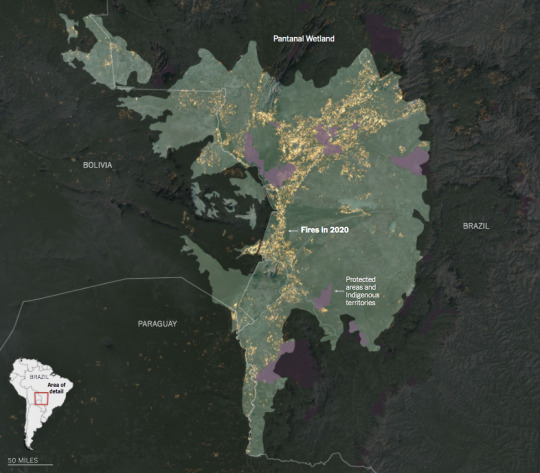
By Scott Reinhard and Blacki Migliozzi·Source: NASA Fire Information for Resource Management System data as of Oct. 12. Protected areas and indigenous territories from the Amazon Geo-Referenced Socio-Environmental Information Network.

Note: Cumulative sum of fire detections across the Pantanal Biome. Data as of Oct. 12. Instruments on Terra and Aqua satellites have experienced periodic failures.·Source: NASA Terra and Aqua satellite data, based on detections with greater than 95 percent confidence levels.
Excerpt from this New York Times story:
The unprecedented fires in the wetland have attracted less attention than blazes in Australia, the Western United States and the Amazon, its celebrity sibling to the north. But while the Pantanal is not a global household name, tourists in the know flock there because it is home to exceptionally high concentrations of breathtaking wildlife: Jaguars, tapirs, endangered giant otters and bright blue hyacinth macaws. Like a vast tub, the wetland swells with water during the rainy season and empties out during the dry months. Fittingly, this rhythm has a name that evokes a beating heart: the flood pulse.
The wetland, which is larger than Greece and stretches over parts of Brazil, Paraguay and Bolivia, also offers unseen gifts to a vast swath of South America by regulating the water cycle upon which life depends. Its countless swamps, lagoons and tributaries purify water and help prevent floods and droughts. They also store untold amounts of carbon, helping to stabilize the climate.
For centuries, ranchers have used fire to clear fields and new land. But this year, drought worsened by climate change turned the wetlands into a tinderbox and the fires raged out of control.
“The extent of fires is staggering,” said Douglas C. Morton, who leads the Biospheric Sciences Laboratory at the NASA Goddard Space Flight Center and studies fire and food production in South America. “When you wipe out a quarter of a biome, you create all kinds of unprecedented circumstances.”
His analysis showed that at least 22 percent of the Pantanal in Brazil has burned since January, with the worst fires, in August and September, blazing for two months straight.
Naturally occurring fire plays a role in the Pantanal, in addition to the burning by ranchers. The flames are usually contained by the landscape’s mosaic of water. But this year’s drought sucked these natural barriers dry. The fires raged out of control, far worse than any since satellite records began.
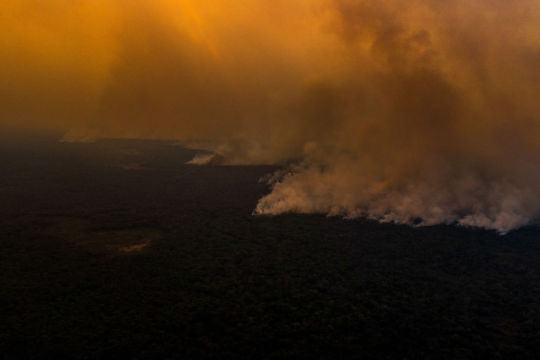
Fires raged through the northern Pantanal, in Mato Grosso State, in August. Maria Magdalena Arréllaga for The New York Times
8 notes
·
View notes
Photo

Photo @lucianocandisani (Luciano Candisani). A couple of nanday parakeet. Pantanal wetlands of Brazil. This region right in the center of south america concentrates a huge abundance of birds. @natgeo @ngbrasil @lucianocandiani @ilcp_photographers #conservation #conservação #expedition #expedição #Pantanal #ecologia #fotografia #photography #wetland #bird #parrot #wildlife #lucianocandisani #animais http://ift.tt/2qwwUNw
0 notes